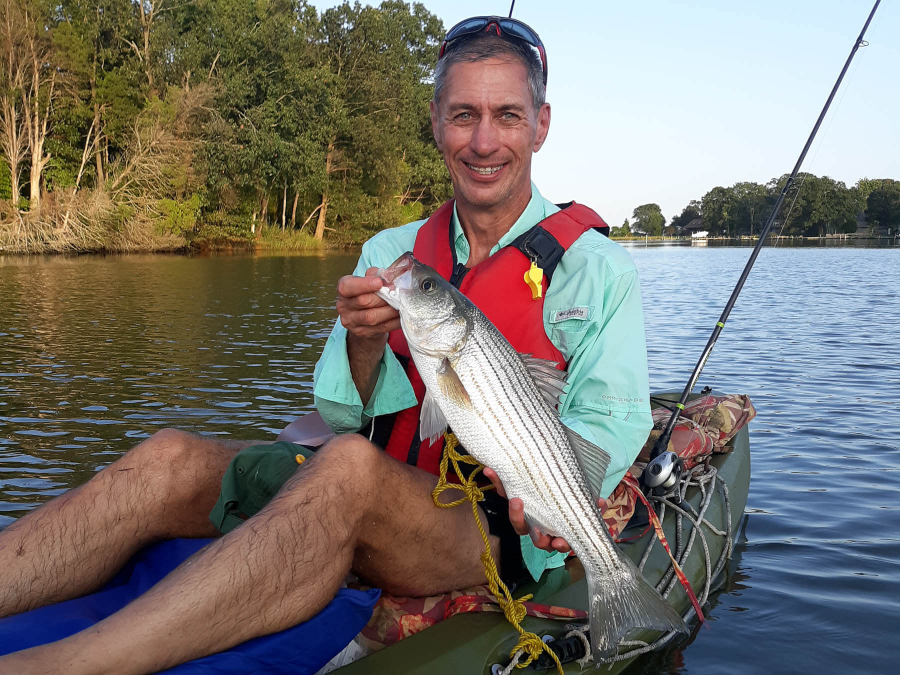My Clean Water Story: Peter Tango
Our monitoring coordinator is still trying to scratch the “water quality itch”

Family legend has it that I was nearly birthed on the banks of the Beaverkill River, a famous trout stream in the Catskill Mountains, New York.
I grew up in a family of devoted hunters and anglers, and mom usually tagged along with dad each weekend to sit and read beside trout streams as dad fished nearby. Even when she was pregnant with yours truly, my mom continued to visit tributaries like Beaverkill. But on one particular weekend, mom wasn’t quite feeling up to it, and wanted to stay home. Dad, who trout fished even on their honeymoon, surprisingly stayed home that weekend, too.
And so, I was born that weekend at the local hospital instead of streamside, but for all those months in the womb listening to the flows of those mountain streams, it seems natural to me that I would be hooked for a life deeply connected with water.
I fully embraced the outdoor life of my family. In the summer, grandpa and grandma had a cottage with access to a gorgeous lake full of freshwater grasses. Swimming in its silky, clean, clear waters was the best way to keep cool and enjoy the peaceful surroundings. And there was outstanding fishing.
Fish in the Catskills were diverse, which tickled my curiosity early in life about their variety. On weekends, I became dad’s sidekick and we fished beautiful cold-water streams and the New York City reservoir system for their lovely trout. For a while, I lived with mom in central Florida, in a trailer, on a beautiful lake full of big bass, schools of threadfin shad, odd looking gar, unusual bowfin and the occasional alligator. In my late teens, I spent a couple of years competing in bass fishing tournaments on other amazing waterways. I really had the good fortune of living around, and spending time in, many miles and acres of otherwise pristine waterways, not really knowing or understanding much about pollution.

Coming out of high school, I dove into an education and career path centered on sustaining and improving natural resources. Right around the time I graduated from the State University of New York’s College of Environmental Science and Forestry (SUNY-CESF), in 1986, there was an article in the local newspaper reporting on the New York State Department of Environmental Conservation survey of Onondaga Lake. The department staff were catching big smallmouth bass, walleye and other species in abundance. That bit of natural resource news stuck with me as odd because Onondaga Lake had been labeled as the most polluted lake in the nation, and possibly the world.
The lake had significant water chemistry issues, shoreline habitat issues and a summer dead zone. I could not get that juxtaposition out of my head: the combination of an abundance of large game fish that seemed to be living well under what had been described as some of the most awful water quality in the world. The situation seemed to run contrary to what we expect about the interaction between pollution and living resources. I felt that society needed to understand how this was possible, given the recognition of many pollution-affected waters in the country and around the globe during the 1980’s.
A few years went by. I had gone out and completed my Master’s in Science degree at West Virginia University in Wildlife Management, where I spent time restoring river otter populations in West Virginia., then roamed the East Coast of the U.S. loving life, doing a variety of seasonal jobs in the natural resource field. But all along I kept coming back to that complex and mysterious interaction between fish and water quality. I couldn’t stand it anymore. I had to scratch the curiosity itch.
And so, I met with an advisor back at SUNY-CESF, expressed my interests, volunteered for a summer of fishery surveys out on the lake and then was able to get into a Ph.D. program. For my dissertation, I was able to study waters in and around Onondaga Lake. It turns out that while the lake had several issues—summer dead zone, toxics exposure, industrial waste laden shorelines and impaired sediment—fish found ways to avoid these conditions. The trout we caught in winter when there was no dead zone could find summer refuge in the cold-water streams that fed into the lake. The bass and walleye could move in and out of the lake into the Seneca River system that was cleaner and healthier than Onondaga Lake. Essentially, the fish could exploit the best of what the lake had to offer in different seasons, but they didn’t have to live there all year-round, every year of their life.
After completing my degree, I asked myself what environmental system looked like a good place to apply what I had learned to be able to help in their restoration efforts. I landed on the Chesapeake Bay.
I started working as a contractual scientist for the Maryland Department of Natural Resources (MD DNR) Wildlife and Heritage Division before landing a position with their Tidewater Ecosystem Assessment team. After a decade of work with DNR, I moved into the Chesapeake Bay Monitoring Coordinator role at the Chesapeake Bay Program in 2006. In this role, I have the privilege of helping to monitor the Bay watershed—reporting on the water quality and ecosystem changes that impact the marine life that I love and am forever fascinated by.
My Clean Water Story reflects on my personal connections to the Bay and its watershed that extend now for over 30 years. My wife and I recreate on and around these ever-improving waters, catching fresh fish that nourish our bodies and souls. I continue to be excited by the Bay Program’s efforts to restore and sustain habitat quality. And I continue to be optimistic about the resilience of the Bay’s ecosystems and wildlife.

Comments
Hi Kent! So good to hear from you! Yes, it is an honor to follow in your footsteps as I think now only the 4th or 5th Monitoring Coordinator of the program. You set us on the right path when you were here :-). Godspeed to you as well, best wishes, be safe, and take good care always. I/we are always grateful for the foundation you have put in place and we continue to strive to carry that torch forward lighting our way.
Pedter Tango, I remember when Emily Trentacosta was starting to analyze my Osborn Cive Monitoring data you showed up. Marcia Olson always reminded me how great you were, and there you are Monitoring Coordinator, and I was in 1984, the first to hold that job, when only the idea existed. Decades intervene, but ut was wonderful to read your "birthing story" and I send you godspeed in that sacred duty of the monitoring priesthood that should never end.
Thank you!
Your comment has been received. Before it can be published, the comment will be reviewed by our team to ensure it adheres with our rules of engagement.
Back to recent stories